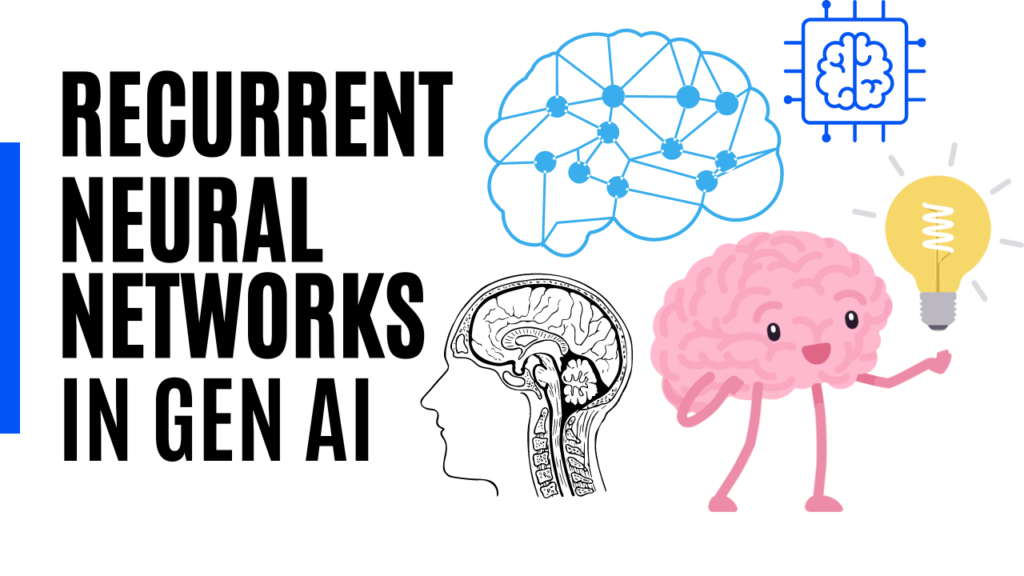1. A Deep Dive into Recurrent Neural Networks (RNNs): Building Blocks of Generative Models

Recurrent Neural Networks (RNNs) are pivotal components in the landscape of generative models. With their inherent ability to process sequential data and capture temporal dependencies, RNNs form the bedrock upon which sophisticated generative algorithms are built. They excel at tasks like language modeling, music generation, and video captioning, all due to their recurrent nature that enables them to retain context over time. RNNs can remember crucial information from the past, making them adept at capturing patterns and generating coherent outputs. By understanding the mechanics of RNNs, we gain insight into their role as the fundamental building blocks that empower generative models to create structured and contextually aware outputs.
2. Generating Realistic Sequences: How RNNs Enhance the Power of Generative Models
Recurrent Neural Networks (RNNs) wield unparalleled influence in the realm of sequence generation within generative models. Their unique architecture, featuring loops that allow information to persist, makes them remarkably suitable for tasks requiring an understanding of context. In the context of music, RNNs can generate melodies that flow naturally and harmonize with established patterns. In text generation, they produce coherent paragraphs that adhere to the language’s syntax. RNNs enhance generative models by allowing them to imbibe the intricacies of sequential data and produce realistic outputs. By training on existing sequences, RNNs gain the ability to capture the nuances of style, tone, and rhythm, effectively elevating the authenticity of generated sequences.
3. Step-by-Step Guide: Implementing RNNs in Generative Modeling for Novices
Implementing Recurrent Neural Networks (RNNs) within generative modeling might seem complex, but with a step-by-step guide, novices can confidently navigate the process. Begin by understanding the core concepts of RNNs, such as the recurrent loops and hidden states. Preprocessing the data and choosing appropriate hyperparameters follow suit. The next steps involve defining the RNN architecture, initializing the model, and setting up the training loop. Through backpropagation and optimization, the model refines its weights to generate coherent sequences. This guide demystifies the intricacies, offering code snippets and insights that empower novices to embrace RNNs in generative modeling with confidence.
4. Unleashing Creativity: RNNs as Creative Engines in Generative Art
Recurrent Neural Networks (RNNs) transcend mere computation, emerging as creative engines that drive generative art to new frontiers. Their capability to learn patterns and contextual dependencies enables them to produce art that resonates with human aesthetics. In generative art, RNNs generate images, paintings, and visual compositions that capture the essence of different styles. Their ability to interpolate between artistic genres makes them tools of innovation, giving birth to art that challenges conventions. By harnessing the latent creativity of RNNs, artists and technologists alike are reshaping the boundaries of what is possible in the realm of generative art.
5. Long Short-Term Memory (LSTM) Networks: Elevating Sequence Generation in Generative Models
Long Short-Term Memory (LSTM) networks, an evolution of Recurrent Neural Networks (RNNs), address their predecessor’s limitations and redefine sequence generation within generative models. LSTMs possess enhanced memory retention, which is crucial for understanding longer dependencies in sequences. This characteristic makes them ideal for tasks like language translation and text generation, where context over longer distances matters. LSTMs have the ability to selectively retain or forget information, enabling them to capture both short-term nuances and long-term dependencies. Their advanced architecture elevates the quality of generated sequences, making them a formidable force in the generative modeling landscape.
6. Beyond Text: RNNs Expanding the Horizons of Generative Music Composition
The influence of Recurrent Neural Networks (RNNs) extends beyond text, captivating the realm of music composition. By analyzing patterns and harmonies, RNNs can generate melodies, chord progressions, and even entire musical compositions. Their ability to capture musical nuances and styles allows them to create music that resonates with listeners. RNNs introduce an innovative dimension to music creation, empowering artists and composers to explore novel harmonies and melodies. This expansion into music composition showcases how RNNs are transcending traditional boundaries and transforming creative domains.
7. Challenges and Solutions: Optimizing RNNs for Stable Training in Generative Models
While Recurrent Neural Networks (RNNs) excel in generative tasks, they come with challenges during training. Issues like vanishing gradients and slow convergence can hinder stability. However, solutions abound. Gradient clipping, weight initialization techniques, and employing advanced RNN variants like LSTMs and GRUs can mitigate gradient vanishing. Optimizers like Adam and RMSProp offer better convergence rates. Additionally, using dropout and batch normalization can enhance model generalization. By understanding these challenges and implementing effective solutions, practitioners can harness the full potential of RNNs in generative modeling, ensuring stable and efficient training.
8. Real-World Applications: RNNs Fueling Innovations in Language Generation
The real-world impact of Recurrent Neural Networks (RNNs) is vividly seen in their contributions to language generation. From chatbots engaging in natural conversations to auto-completion suggestions and language translation, RNNs drive the advancement of language-related applications. They capture contextual nuances and generate coherent and contextually relevant text. RNN-based language models like GPT-3 excel in generating human-like text, enabling applications that improve productivity and facilitate seamless communication. These real-world applications underscore RNNs’ significance in shaping modern communication technologies.
9. Comparing RNN Variants: Which Architectures Excel in Different Generative Tasks
The landscape of Recurrent Neural Networks (RNNs) is diverse, encompassing various architectural variants like Vanilla RNNs, LSTMs, and GRUs. The choice of architecture significantly impacts the performance of generative tasks. Vanilla RNNs are simple but struggle with vanishing gradients. LSTMs excel in capturing long-range dependencies, while GRUs offer a balance between simplicity and performance. Understanding the strengths and weaknesses of each variant allows practitioners to tailor their choice to specific generative tasks, optimizing the trade-off between complexity and effectiveness.
10. Ethical Considerations: Navigating Biases and Fairness in RNN-Driven Generative Models
As Recurrent Neural Networks (RNNs) create content, ethical considerations come to the forefront. These models can inadvertently inherit biases present in training data, leading to biased outputs. Navigating fairness and mitigating biases in RNN-driven generative models is crucial. Techniques like dataset augmentation, careful data curation, and adversarial training can help address these challenges. Responsible AI practices ensure that the outputs generated by RNNs are aligned with ethical standards, promoting inclusivity, fairness, and unbiased creativity.
Conclusion

In conclusion, the realm of Recurrent Neural Networks (RNNs) within generative models is a captivating journey that fuses technology and creativity. By diving into the depths of RNNs, we’ve uncovered their pivotal role as the building blocks of generative models, powering sequence generation across various domains. These networks amplify the authenticity of generated sequences, whether in music, art, or language, making them invaluable tools for creative expression.
The step-by-step guide equips novices with the confidence to implement RNNs in generative modeling, democratizing their potential for all. RNNs are not just computational entities; they are creative engines that reshape the boundaries of generative art, infusing innovation into traditional disciplines. The introduction of Long Short-Term Memory (LSTM) networks elevates the quality of sequences, allowing them to capture intricate temporal dependencies and enriching generative outputs.
The expansion of RNNs beyond text, into the realms of music and language, showcases their versatility and transformative capabilities. Challenges encountered during training are met with effective solutions, ensuring stable and efficient RNN utilization. As RNNs fuel real-world language innovations and excel in various generative tasks, their architectural variants offer tailored solutions, each optimized for specific applications.
Amid these advancements, ethical considerations remain paramount. Addressing biases and ensuring fairness in RNN-driven generative models is crucial to fostering responsible AI creativity. Through these diverse subtopics, we’ve navigated the vast landscape of RNNs in generative models, unveiling their multifaceted impact on technology, creativity, and ethics. As we move forward, RNNs will continue to shape the future of generative art, music, language, and beyond, guided by a commitment to innovation, inclusivity, and ethical integrity.


I conceive you have noted some very interesting points, thankyou for the post.